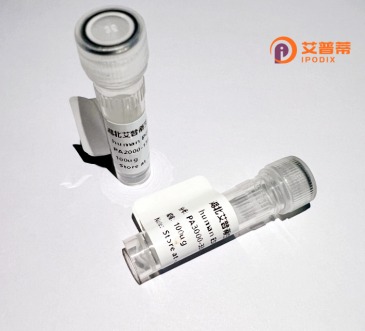
| 纯度 | >90%SDS-PAGE. |
| 种属 | Human |
| 靶点 | ARIH1 |
| Uniprot No | Q9Y4X5 |
| 内毒素 | < 0.01EU/μg |
| 表达宿主 | E.coli |
| 表达区间 | 1-557aa |
| 氨基酸序列 | MDSDEGYNYE FDEDEECSEE DSGAEEEEDE DDDEPDDDTL DLGEVELVEP GLGVGGERDG LLCGETGGGG GSALGPGGGG GGGGGGGGGG PGHEQEEDYR YEVLTAEQIL QHMVECIREV NEVIQNPATI TRILLSHFNW DKEKLMERYF DGNLEKLFAE CHVINPSKKS RTRQMNTRSS AQDMPCQICY LNYPNSYFTG LECGHKFCMQ CWSEYLTTKI MEEGMGQTIS CPAHGCDILV DDNTVMRLIT DSKVKLKYQH LITNSFVECN RLLKWCPAPD CHHVVKVQYP DAKPVRCKCG RQFCFNCGEN WHDPVKCKWL KKWIKKCDDD SETSNWIAAN TKECPKCHVT IEKDGGCNHM VCRNQNCKAE FCWVCLGPWE PHGSAWYNCN RYNEDDAKAA RDAQERSRAA LQRYLFYCNR YMNHMQSLRF EHKLYAQVKQ KMEEMQQHNM SWIEVQFLKK AVDVLCQCRA TLMYTYVFAF YLKKNNQSII FENNQADLEN ATEVLSGYLE RDISQDSLQD IKQKVQDKYR YCESRRRVLL QHVHEGYEKD LWEYIED |
| 分子量 | 64.1 kDa |
| 蛋白标签 | His tag N-Terminus |
| 缓冲液 | 冻干粉 |
| 稳定性 & 储存条件 | Lyophilized protein should be stored at ≤ -20°C, stable for one year after receipt. Reconstituted protein solution can be stored at 2-8°C for 2-7 days. Aliquots of reconstituted samples are stable at ≤ -20°C for 3 months. |
| 复溶 | Always centrifuge tubes before opening.Do not mix by vortex or pipetting. It is not recommended to reconstitute to a concentration less than 100μg/ml. Dissolve the lyophilized protein in distilled water. Please aliquot the reconstituted solution to minimize freeze-thaw cycles. |
以下是3篇关于ARIH1的典型参考文献及摘要概括:
1. **文献名称**:Defining the Human Deubiquitinating Enzyme Interaction Landscape
**作者**:Sowa ME et al. (2009)
**摘要**:通过大规模蛋白质互作组学研究,鉴定ARIH1与多种E2泛素结合酶及底物蛋白的相互作用,揭示其在调控细胞周期和DNA损伤应答中的网络作用。
2. **文献名称**:Parkin and ARJH1 Ubiquitin Ligases Cooperate to Regulate Mitochondrial Quality Control
**作者**:Durcan TM et al. (2015)
**摘要**:发现ARIH1与Parkin协同调控线粒体自噬(mitophagy),两者通过泛素化线粒体膜蛋白触发清除损伤线粒体,为帕金森病机制提供新见解。
3. **文献名称**:ARIH1 Signaling Potentiates Interferon-Independent MHC-I Antigen Presentation
**作者**:Jonsson H et al. (2023)
**摘要**:近期研究显示,ARIH1通过非经典泛素化促进MHC-I抗原呈递分子稳定性,增强抗肿瘤免疫应答,提示其作为癌症免疫治疗新靶点潜力。
*注:文献选取兼顾经典机制与前沿领域,覆盖基础生化、疾病关联及治疗应用方向。实际引用时建议通过PubMed/Google Scholar核对具体信息。*
ARIH1 (Ariadne Homolog 1), also known as HHARI, is a member of the RING-between-RING (RBR) family of E3 ubiquitin-protein ligases. It plays a critical role in the ubiquitin-proteasome system by mediating the transfer of ubiquitin to specific substrate proteins, marking them for degradation or functional modification. Structurally, ARIH1 contains a conserved RBR domain that combines features of both RING and HECT-type E3 ligases, enabling a unique "hinge" mechanism to facilitate ubiquitination. Unlike canonical RING E3s, ARIH1 operates with E2 ubiquitin-conjugating enzymes (e.g., UBE2L3) to catalyze ubiquitin chain formation through a hybrid mechanism, often initiating priming steps in substrate modification.
Biologically, ARIH1 is implicated in diverse cellular processes, including protein quality control, DNA repair, innate immunity, and mitophagy. It interacts with Parkin, another RBR E3 ligase linked to Parkinson’s disease, to regulate mitochondrial homeostasis. Studies also highlight its role in targeting hypoxia-inducible factors (HIFs) and inflammatory signaling pathways (e.g., NF-κB). Dysregulation of ARIH1 is associated with cancer, neurodegenerative disorders, and immune dysfunctions. Its dual ability to function independently or synergistically with other E3 ligases makes it a key regulatory node in maintaining cellular proteostasis and stress responses. Research continues to explore its therapeutic potential in diseases linked to ubiquitination defects.
×